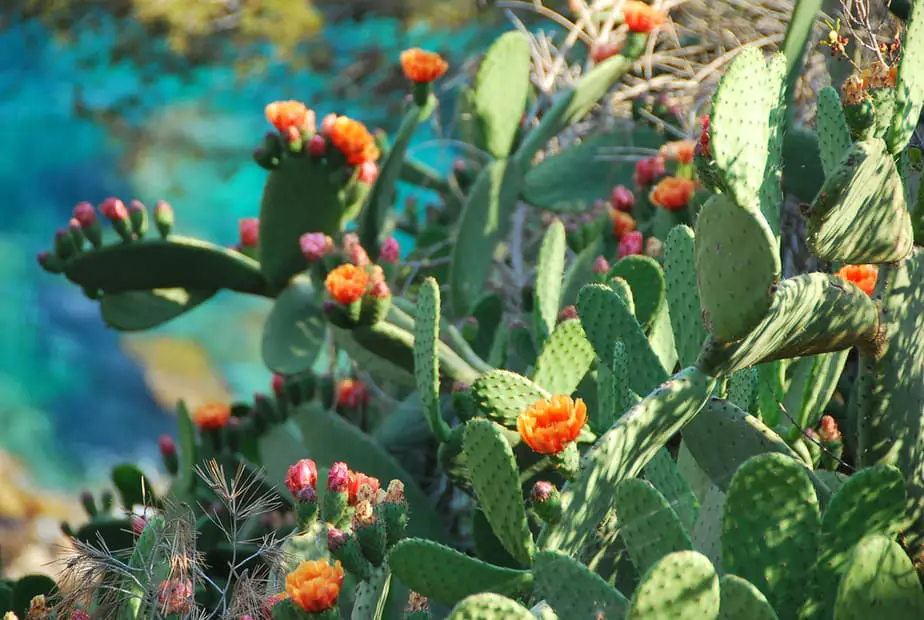Although the desert may seem like a dry and arid terrain, it is home to hundreds of colorful, flowering desert plants. Using the Arizona desert as an example, there are many trees, grasses, wildflowers, cacti, and shrubberies scattered across the hot desert landscape.

Whether you would like a new garden aesthetic or are on the hunt for drought-tolerant plants, there are plenty of options to suit any need. Search no further, below are some of our top picks for easy to maintain, flowering desert plants:
Table of Contents
Shrubs and Trees
Tecoma Stans: Also known as ‘Yellow Bells,’ this native American shrub thrives in full sunlight or filtered shade. The bright and bold yellow flowers are an excellent option for your new garden as they grow quickly and bloom in abundance. If well maintained, the shrub can grow to 32 feet (10 meters) high, making a bold statement in your garden.
Callistemon (Bottlebrush): The bottle brush family is a native Australian shrub or small tree that flowers in shades of cream, yellow, pink, or red. These drought-resistant plants are an easy-care option that will attract bees and birds to your garden with its sweet nectar.
Wildflowers
Kallstroemia Grandiflora: Also known as an Arizona poppy, Summer Poppy, or Orange Caltrop, this flowering herb can be found in the deserts of California, and Northern Mexico. If you have a large and dry landscape, this flower can spread to 1-3 feet (30cm – 1 meter) tall and 3 feet (1 meter) wide. Maintenance for these hardy flowers is easy, only requiring occasional watering, and no feeding or pruning required.
Desert Marigold: If you live in a dry, hot, and windy landscape, the Desert Marigold is a sturdy desert wildflower that will flower throughout the warm months and return year after year. This specimen can grow between 10-30 inches (25-70cm) and doesn’t require any particular soil type, just good drainage.
Cactus and Succulents
Prickly Pear: This cactus is an excellent choice for your desert-themed garden. It is an easygoing and hardy plant to grow, which will bloom bright flowers during the spring and edible fruits in maturity. After approximately eight years, your cactus can yield as many as 200 fruits, making an excellent addition to a healthy smoothie.
Ice Plant: If you are searching for colorful succulents that can fill your inhospitable and dry patches of desert garden, Ice Plants are the right choice for you. With their many yellow, pink, purple, and red flowers, this gorgeous succulent creates an ideal covering for the rocky slopes or dusty ground. Many gardeners like this succulent as they attract butterflies, bees, and birds to their otherwise harsh desert landscape.
Grasses
Muhly Grass: Muhlenbergia is an ornamental green grass that flowers into a beautiful pink or white spectacle. This widespread grass can be found in the Arizona Desert and throughout Mexico, Canada, Asia, Central, and South America. The geographical diversity of the plant makes it extremely adaptable and fast-growing in a variety of soils. Even with no flowers, this green grass adds texture, color, and fullness to your garden year-round.
How Can I Keep My Succulents And Desert Plants Happy For The Winter?
As temperatures begin to drop, you may be wondering whether your succulents and desert plants will survive. The good news is even deserts get cold, sometimes dropping below freezing at night. However, if the weather remains continuously cold and wet, your plants may struggle.
Luckily, there are many steps you can take to ensure your plants will thrive during these harsher months.
Cover your young and vulnerable plants when the cold temperatures arrive. The cover should go over the top of the plants so that it is fully covered, protecting it from wind, rain, and frost. These specially designed plant covers can be purchased at most garden stores.
It is crucial to continue conscientiously watering your desert plants throughout the winter months. When frost forms on the surface of your plant, it draws the water away, potentially causing dehydration and damage. A hydrated plant is much more likely to survive the colder climates.
When landscaping, it is important to frequently search your plants for pests such as aphids and mealybugs. If found, move your infested plants away from the others and mist with a mixture of ¾ alcohol and ¼ water.
Succulents are especially delicate in the winter. Where possible, move your plants inside. Begin the process by removing any weeds, and leaves around the succulents and then repot them using new soil. Leave the succulent in its new pot for two weeks before moving it inside, and gradually reduce the amount of watering. Once inside, place your plants on a windowsill with lots of sunlight.
If it is impossible to bring your succulents inside, ensure that you plant them in a spot that will receive at least 3-4 hours of bright sunlight per day. If you live in a wet climate, ensure that you purchase a dry succulent mix that will keep any excess water at bay. Otherwise, it can contribute to rotting.
Making The Most Out Of Your Desert Landscape Design
When designing your perfect desert landscape, remember to play around with plants that will provide a variety of contrast. Great landscaping incorporates a mixture of color, shape, texture, and size. Using a plant from each of the categories listed: trees, grasses, wildflowers, cacti, and shrubs will enable your unique desert garden to stand out.